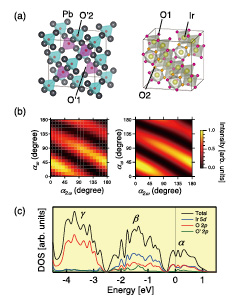Mechanism of Enhanced Second-Harmonic Generation in Noncentrosymmetric Metal
Ohgushi, Suemoto, and Tajima Groups
Solids without spatial inversion symmetry attract great interests in the current condensed matter physics. The most common and well-studied systems without inversion symmetry are the ferroelectrics, where macroscopic polarization appears in an insulating state. Recently, conductive materials without inversion symmetry, which are known as noncentrosymmetric metals, have also attracted interest. In contrast to ferroelectrics, noncentrosymmetric metals do not exhibit macroscopic polarization due to screening by conducting electrons; instead the state is characterized by a higher-rank tensor (e.g. piezo-electric tensor). The breakdown of inversion symmetry is considered to influence the transport properties. For example, it is theoretically predicted that the inverse Faraday effect can be induced by Rashba interaction [1]. However, there have been few experimental studies [2], because noncentrosymmetric metals are rare.

Fig. 1. (a) Crystal structure of Pb2Ir2O6O’, which can be viewed as a sum of two interpenetrating units, Pb2O’ and Ir2O6. (b) Polarization dependence of the observed (left) and simulated (right) second-harmonic generation signals for Pb2Ir2O6O’. αω and α2ω stand for polarization of incident and generated beams, respectively. (c) Total and partial density of states obtained from the first-principles calculation. SHG signals originate from dipolar transitions among the bands labeled as α, β, and γ. The large hybridization of O’ 2p orbitals with α and β bands results in the observed large SHG signals.
We investigated electronic properties of a noncentrosymmetric metal Pb2Ir2O6O’, which has the pyrochlore-type structure consisting of the Pb2O’ and Ir2O6 building units [3]. Structural analysis revealed that the structural distortion relevant to the breakdown of the inversion symmetry is dominated by the Pb2O’ unit but is very small in the Ir-O network. Nevertheless, gigantic second-harmonic generation (SHG) signal originating from the Ir 5d electrons, which is as large as SHG signals of GaAs, was observed. First-principles electronic structure calculations reveal that the underlying mechanism for this phenomenon is the induction of the noncentrosymmetricity in the Ir 5d bands by the strong hybridization with O’ 2p orbitals, which are unique characteristics of Pb-containing pyrochlore-type oxides. Our results stimulate theoretical study of inversion broken iridates, where exotic quantum states such as a topological insulator and Dirac semimetal are anticipated.
References
- [1] V. M. Edelstein, Phys. Rev. Lett. 80, 5766 (1998).
- [2] K. Ohgushi, J. Yamaura, M. Ichihara, Y. Kiuchi, T. Tayama, T. Sakakibara, H. Gotou, T. Yagi, and Y. Ueda, Phys. Rev. B 83, 125103 (2011).
- [3] Y. Hirata, M. Nakajima, Y. Nomura, H. Tajima, Y. Matsushita, K. Asoh, Y. Kiuchi, A.G. Eguiluz, R. Arita, T. Suemoto, and K. Ohgushi, Phys. Rev. Lett. 110, 187402 (2013).
